American crocs coming back in Florida
upi.com
In the 1970s, the population of American crocodiles in the deep Everglades numbered about 150, The Miami Herald reported Sunday. Now, scientists say, their numbers have increased to about 1,500.
While crocodiles still are vastly outnumbered by alligators, their increasing population has meant run-ins with humans have become more frequent. And their protected status presents challenges in dealing with them.The Florida Fish and Wildlife Conservation Commission responded to 106 "nuisance'' croc calls in 2011 -- more than 80 percent of those were from Miami-Dade and Monroe counties.
"There is no question that with the increase in the crocodile population, encounters are much more common," said Lindsey Hord, a biologist in charge of FWC's nuisance reptile program.The state's 1 million alligators produced about 15,000 nuisance calls a year.
Salt-water crocodiles, on the other hand, though removed from the U.S. Fish and Wildlife Service's endangered species list in 2007, remain "threatened," which affects how responders handle calls about nuisance crocs, Hord said.
"That's not a hard-and-fast rule," Hord said. "Realistically, public safety is our absolute first priority but we have to recognize the need of the species."
Although there has been no documentation of an American crocodile killing a human in the wild, Mark Parry, a wildlife biologist with Everglades National Park, said it will likely happen.
"Sooner or later there will probably be, just like with the Florida panther, a first attack on a human," he said.
--------------------------------------------------------------------------
Ecology and Conservation of the American Crocodile (Crocodylus acutus) in Florida
Authors
Frank J. Mazzotti, Michael S. CherkissAbstract
The American crocodile (Crocodylus acutus) is primarily a coastal crocodilian that is at the northern end of its range in southern Florida. In Florida, habitat loss from human development has been the primary factor in this endangered species decline. Currently, they face new issues--Florida Bay has undergone a number of changes that have caused a great deal of concern for the ecological health of this ecosystem and primary crocodile habitat. Efforts have been, and continue to be, made to improve Florida Bay and Biscayne Bay. In south Florida we have the unique opportunity to integrate endangered species conservation with ecosystem restoration and management. American crocodiles thrive in healthy estuarine environments, and are particularly dependent on freshwater deliveries. Recovery of the American crocodile in Florida will require an integration of habitat enhancement for an endangered species with environmental education. As crocodiles benefit from a restored freshwater flow into estuaries, their numbers will increase. The challenge of integrating a recovering population of the American crocodile with an ever increasing use of coastal areas by humans will require a proactive educational program and will be the final challenge in the successful recovery of this once critically endangered species.Background
- The American crocodile is a primarily tropical species reaching the northern end of its range in southern Florida.
- Undiscovered until 1869, the American crocodile has always been considered rare in Florida.
- Habitat loss in southeastern Florida has been the primary reason for population decline.
- The American crocodile was listed as endangered by the USFWS in 1975.
 | |
| Distribution of the American Crocodile |
Research, Monitoring and Modeling
- The population biology of the American crocodile in southern Florida has been studied through surveys for crocodiles and nests by a number of individuals and groups since the 1970's.
- Study areas have included Everglades National Park (ENP), Crocodile Lake National Wildlife Refuge (CLNWR), the Turkey Point Power Plant site (TP) and more recently Biscayne Bay and SW Florida.
- Our current efforts focus on determining the status of crocodiles in Florida as part of the Multi-Species Recovery Plan and evaluating the effects of alternative water delivery plans to the Everglades and Biscayne Bay estuaries as part of the Comprehensive Everglades Restoration Plan.
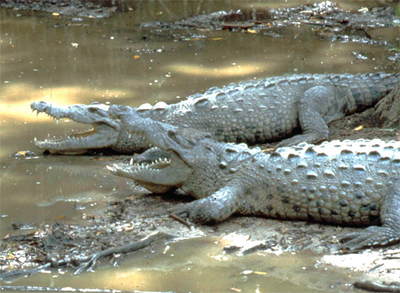
Methods and Results
- Distribution, relative abundance, habitat relation, growth and survival of crocodiles in Florida are determined by periodic surveys of crocodile habitat.
- Nesting effort and success are determined by searching known and potential nesting habitat during egg laying (April and May) and nest hatching (July and August).

Crocodile Nests in the Southern Tip of Florida and the Florida Keys
- Crocodiles now occur in areas where they never occurred before. Examples include public beaches, county parks, marinas, golf courses, and an airport.
- This has caused a growing problem with human/crocodile interactions. Out of miseducation and fear people react to crocodiles as a threat and nuisance rather than a natural history attraction and endangered species success story.
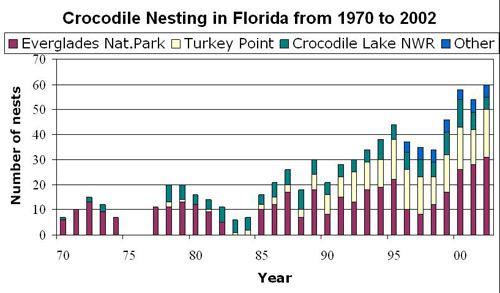
- The number and range of crocodiles and nests has increased in the last 25 years. Crocodiles have reoccupied southern Biscayne Bay and are found in Broward and Collier Counties.
- Most of the increase in crocodile nests has occurred on artificial substrates. This has to some extent compensated for the loss of nest sites due to development.

- Crocodiles in the least physically altered habitats of ENP grow slower and have a lower survival rate than crocodiles in the more altered areas at TP and CLNWR.
- We hypothesize that reduced freshwater flows to estuaries has decreased the suitability of those habitats for crocodiles.
Evaluating Everglades Restoration
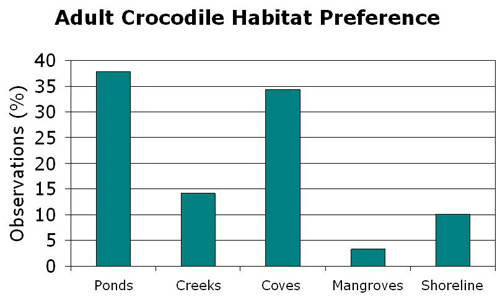
Success Criteria
- Resumption of natural freshwater flow volume and duration to the mangrove estuary will re-establish a salinity gradient with levels <20 ppt in shoreline and tidal creek habitats that will increase the growth and survival of juvenile crocodiles in ENP.
- Maintain current distribution of crocodiles throughout the mangrove transition zone. Increase relative abundance of crocodiles in areas with restored freshwater flow.
- In South Florida we have a unique opportunity to link endangered species conservation with ecosystem restoration and management.
- Crocodiles can be used to evaluate restoration alternatives and determine success criteria for Florida and Biscayne Bays.
Salinity Based Habitat Model
- A habitat suitability model was developed based on data from salinity and habitat relation of crocodiles in ENP and laboratory studies on crocodile growth rates.
- Crocodile habitat was identified as mangrove lined ponds, creeks, coves, and shorelines. Suitability was based on salinity with the most suitable areas defined as between 0-20 ppt, inter-mediate suitability as 20-40 ppt, and least suitable areas as greater than 40 ppt.
- Seasonal isohalines for the sample runs were based on SFWMD monthly water quality summaries.

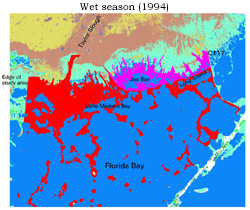 Arcview models of Crocodile habitat suitability of mangroves and coastal prairie in the wet and dry season 1994.
Arcview models of Crocodile habitat suitability of mangroves and coastal prairie in the wet and dry season 1994.(click for larger images)
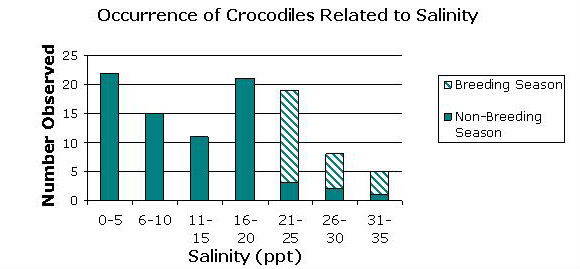
Implications
- More freshwater in northeastern Florida Bay increases the amount of suitable crocodile habitat.
- Under current conditions the most suitable crocodile habitat is closer to the C-111 drainage area than Taylor Slough.
- Increasing freshwater flows through Taylor Slough would produce more suitable crocodile habitat than current conditions.










No comments:
Post a Comment